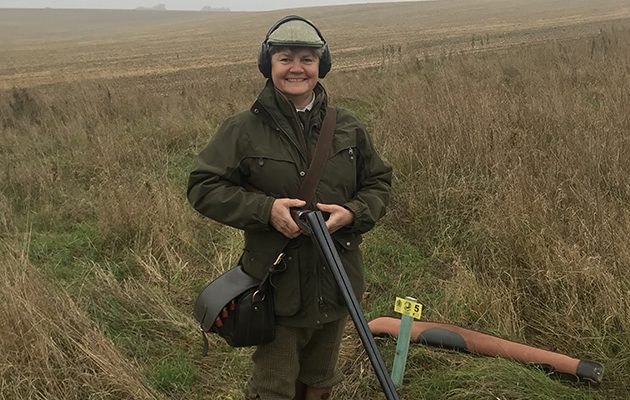A working vet, Gillian Taylor was introduced to fieldsports by the Pony Club. Now a shoot regular, through the pastime she supports the WPA
Gillian Taylor, a working vet, was introduced to fieldsports by the Pony Club as a child, and took up clay-shooting in her thirties. Now a shoot regular, she has taken on all aspects of the shoot – from beating to acting as secretary – and is also on the fundraising committee for the World Pheasant Association.
For more sporting Dianas, seriously sporting ladies offering advice and encouragement, Louise Farmer hopes to inspire the next generation as a regional officer at BASC. And Clare Mills co-founded Anglian Muzzle Loaders to share her passion for powder.
GILLIAN TAYLOR
I come from a non-fieldsports background but when my family moved to Eskdale Green in Cumberland I learnt to ride. Most of my youthful weekends were spent at a local farm riding their ponies and backing youngsters. I attended a couple of West Cumberland Pony Club meets and have vivid memories of trying not to overtake the person wearing the red coat. Our local fell pack was the Eskdale & Ennerdale, which I followed and sent in the occasional report to Horse & Hound.
Watching the farmer’s sons prepare deer carcasses may have been what prompted my interest in becoming a vet. Whilst at university in Liverpool I dabbled with .22 rifle shooting but my main sports were badminton and Vets Mixed Hockey (a fieldsport in its own right). As a student, getting cattle practice with friends near Waberthwaite, I dabbled with fly fishing for brown trout on the River Esk and often chatted to Hugh Falkus, who would pop round for tea.
In my thirties I took up clay shooting, deciding my knees needed a break from competitive badminton. Attending a small corporate day with my husband, Paul, and seeing the clays turned into powder had me hooked straightaway. I have always shot 12-bore, feeling happy with the weight and feel of this calibre. Starting with a Miroku skeet gun I progressed to my current Browning 525. It has served me well for both clays and game – and, on a girlie note, it has a lovely walnut stock and beautiful engraving, so what not to like?
When we moved to rural Hampshire in the mid-1990s, Paul bought a day’s game shooting at a local auction of promises for me. The donor was so surprised that it was for a lady that the words ‘Annie Oakley’ were used. The bid was honoured and I had a fantastic first day out, never to be forgotten.
Soon after that I replied to an advert in our local shop window for a beater at a nearby shoot. The gentleman answering the call sounded a little perplexed at a female enquiry but agreed to interview me at a neutral venue, a pub car park. Choosing my clothing carefully (my oldest wax jacket), I also took along our greyhound, who thought she was a lurcher. Fly and I both passed the test and became regulars on the shoot. For a sighthound she had an excellent nose and would find birds in deep cover, but they had to be quick off the mark. Later I became a half gun at that woodland shoot and have many happy memories of my time there.

She became hooked after a corporate, clay-shooting day.
I am under no illusion that my profession has helped enormously in my fieldsports endeavours as a female. Being a working dog-friendly vet – whether that be lurchers, terriers or gundogs – has given me both a wide network of contacts and credibility.
Through a client I was invited to join a ‘working man’ DIY shoot. This involved work parties to prepare pens, feeding of the birds on a rota system and shoot days where you stood and beat on alternate drives. At that time, as the only lady in the group, I tended to oversee disinfection, health and safety paperwork and later became secretary. It was a learning curve but allowed me to see all aspects of keepering and shoot management. This has stood me in good stead over the years as a gun. Comprehension of how shoots work and how this relates to shoot safety has also been helpful now I am a qualified loader. I am certified and have been given some opportunities this season. I hope to get more work in the future but know it will take time to become trusted as a reliable team member.
Training my black labs to work at shoots is so satisfying. I attended a local shoot as a regular ‘hobbyist’ with Ghillie, my first lab, and this season I have been beating at three shoots, loading at another two and had about a dozen days shooting. These have ranged from walked-up days – the pressure of the one bird over your head scenario – to amazing driven days in stunning countryside.
For me, any day, in whatever role I am assuming, is about the company and countryside. People make the day and we should all remember not to take that for granted. I am also involved with the fundraising committee of the World Pheasant Association – The Field is one of our regular supporters. As a relatively small conservation charity the annual shoot and auction is one of our key fundraisers. Our work ranges from education and conservation in Nepal to black grouse projects in the UK and preservation of the black-necked pheasant in Greece.
TOP TIPS: Make sure your dog is warm and watered during the shoot lunch. If loading, have spare sunglasses with you. When beating, don’t ‘borrow’ the flags. Always be courteous, it’s a small world. What happens on a shoot stays on the shoot. If a guest why not donate a sum to charity in lieu of birds shot?





